Your network contains an Active Directory Domain Services (AD DS) domain.
You have a Group Policy Object (GPO) named GPO1 that contains Group Policy preferences.
You plan to link GPO1 to the domain.
You need to ensure that the preference in GPO1 apply only to domain member servers and NOT to domain controllers or client computers. All the other Group Policy settings in GPO1 must apply to all the computers. The solution must minimize administrative effort.
Which type of item level targeting should you use?
Note: This question is part of a series of questions that present the same scenario. Each question in the series contains a unique solution that might meet the stated goals. Some question sets might have more than one correct solution, while others might not have a correct solution.
After you answer a question in this section, you will NOT be able to return to it. As a result, these questions will not appear in the review screen.
You are planning the deployment of DNS to a new network.
You have three internal DNS servers as shown in the following table.

The contoso.local zone contains zone delegations for east.contoso.local and west.contoso.local. All the DNS servers use root hints.
You need to ensure that all the DNS servers can resolve the names of all the internal namespaces and internet hosts.
Solution: You configure Server2 and Server3 to forward DNS requests to 10.0.1.10.
Does this meet the goal?
Your network contains an on-premises Active Directory Domain Services (AD DS) domain named contoso.com The domain contains three servers that run Windows Server and have the Hyper-V server rote installed. Each server has a Switch Embedded Teaming (SET) team
You need to verity that Remote Direct Memory Access (RDMA) and all the required Windows Server settings are configured properly on each server.
What should you use?
Your network contains two Active Directory forests and a domain trust as shown in the following exhibit.
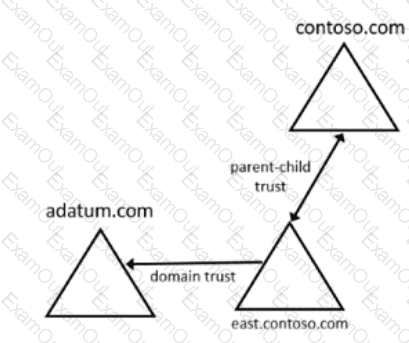
The domain trust has the following configurations:
• Name: adatum.com
• Type: External
• Direction: One-way. outgoing
• Outgoing trust authentication level: Domain-wide authentication
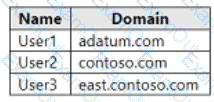
The forests contain the network shares shown in the following table.
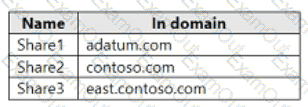
For each of the following statements, select Yes if the statement is true. Otherwise, select No. NOTE: Each correct selection is worth one point.

You have an Azure virtual machine named VM1 that has a private IP address only.
You configure the Windows Admin Center extension on VM1.
You have an on-premises computer that runs Windows 11. You use the computer for server management.
You need to ensure that you can use Windows Admin Center from the Azure portal to manage VM1.
What should you configure?
You have two on-premises servers named Server1 and Servet2 that run Windows Server.
You have an Azure Storage account named storage1 that contains a file share named share'. Server1 syncs with share1 by using Azure File Sync
You need to configure Server2 to sync with share1.
Which three actions should you perform in sequence? To answer, move the appropriate actions from the list of actions to the answer area and arrange them in the correct order.

Note: This question is part of a series of questions that present the same scenario. Each question in the series contains a unique solution that might meet the stated goals. Some question sets might have more than one correct solution, while others might not have a correct solution.
After you answer a question in this section, you will NOT be able to return to it. As a result, these questions will not appear in the review screen.
You have a server named Server1 that runs Windows Server 2022 and has the DHCP Server role. Server1 contains a single DHCP scope named Scope1.
You deploy five printers to the network.
You need to ensure that the printers are always assigned the same IP address.
Solution: You create a DHCP reservation for each printer.
Does this meet the requirement?
You have a server named Server1 that runs Windows Server Server1 has a just-a-bunch-of-disks (JBOD) enclosure attached.
You plan to create a storage pool on Server1 and a virtual disk that will use a mirror layout.
You are considering whether to use a two-way or a three-way mirror layout.
What is the minimum number of disks required for each type of minor layout? To answer, select the appropriate options in the answer area.
NOTE: Each correct selection is worth one point.
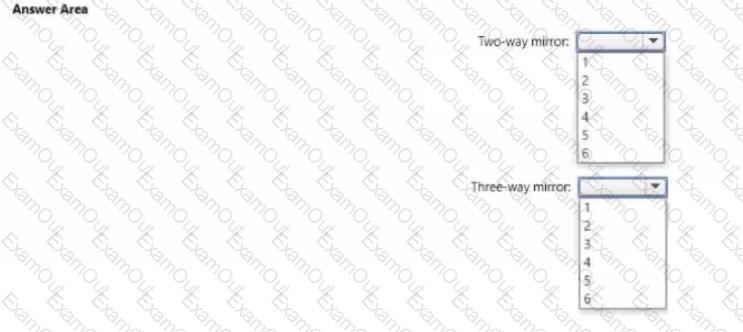
Your network contains an Active Directory Domain Services (AD DS) domain named adatum.com. The domain contains a file server named Server1 and three users named User1, User2, and User3.
Server1 contains a shared folder named Share1 that has the following configurations:
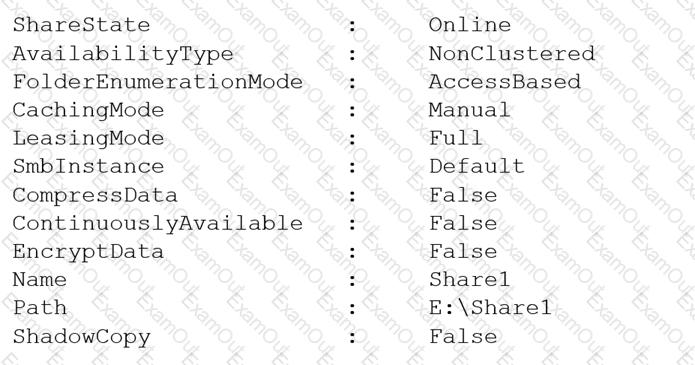
The share permissions for Share1 are configured as shown in the Share Permissions exhibit.
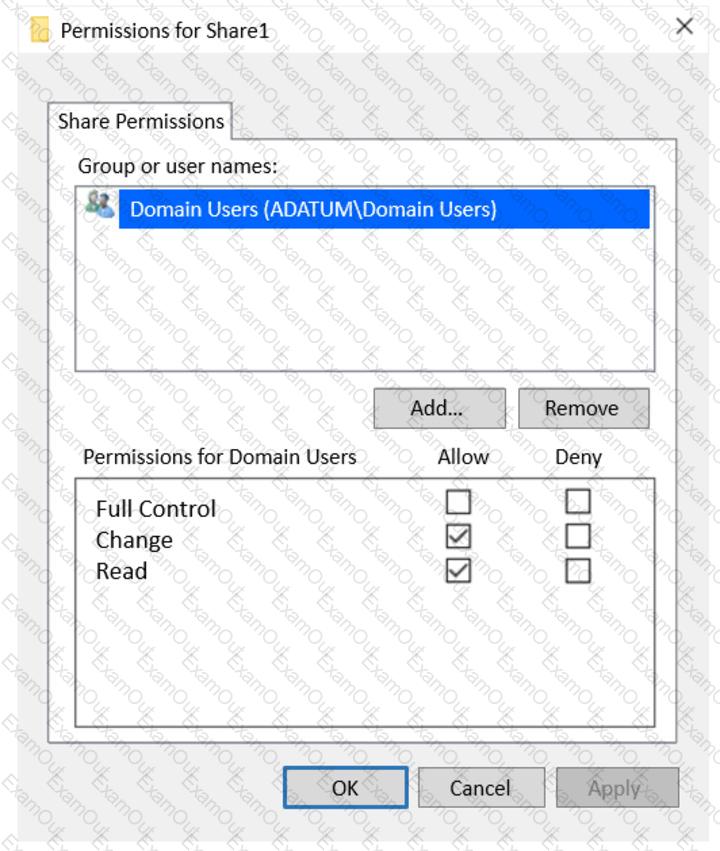
Share1 contains a file named File1.bxt. The share settings for File1.txt are configured as shown in the File Permissions exhibit.
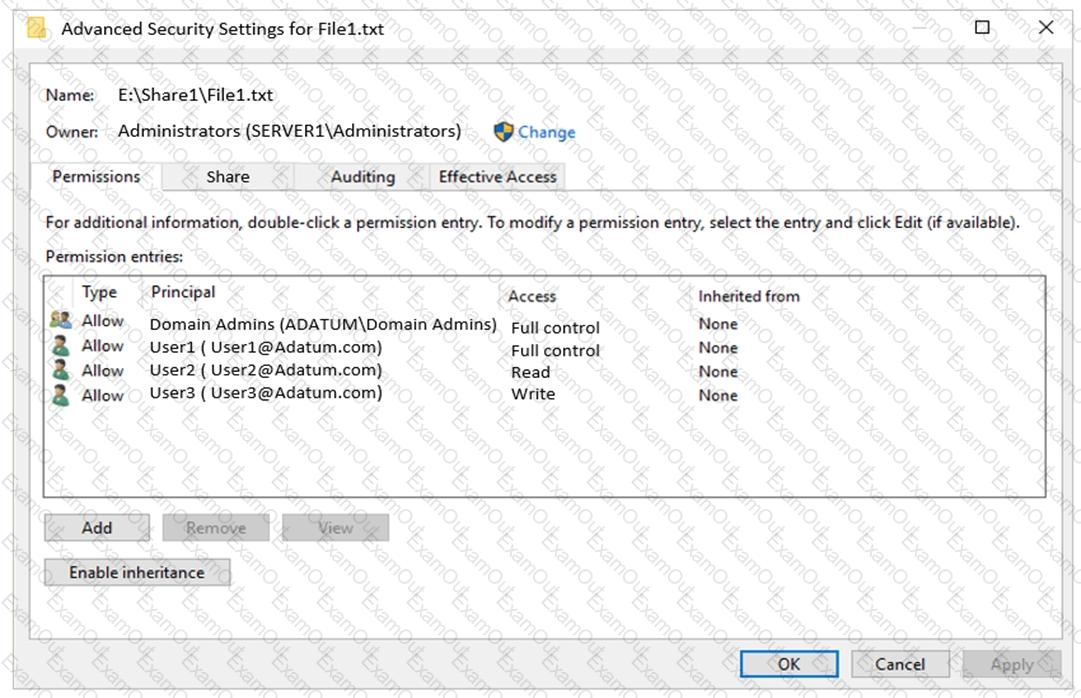
For each of the following statements, select Yes if the statement is true. Otherwise, select No.
NOTE: Each correct selection is worth one point.

You have an Active Directory Domain Services (AD DS) domain. The domain contains a member server named Server1 that runs Windows Server.
You need to ensure that you can manage password policies for the domain from Serve1.
Which command should you run first on Server1?





